Learn how to tie three great Coypu patterns: the Crab Monster, the Coypu Dab, and the Coypu Bonefish Fly.

To begin at the beginning. Last year, a friend of mine who lives deep in the woods in Norway and deals in unusual furs for fly tying, sent me an assortment of all kinds of fur strips to play around with. Among them were two especially interesting furs: kangaroo and coypu.
The flies I tied with the kangaroo strips were wonderfully beautiful but they had the unfortunate habit of hopping off the tying bench when finished and I haven't found them yet. When I do, I'll report back to you.
The coypu flies, however, stayed put . And so I had more of an opportunity to weigh their merits. Not that I've actually caught fish on them myself--not yet, anyway--but I tied up some crablike "critters" and coypu bonefish flies and gave some to friends to try out in Belize and Mexico. Reports back were much better than I expected, especially since these particular friends are fairly new to the sport. Notwithstanding, they caught some very respectable numbers of permit and quite a few bonefish on these flies. And so I'm encouraged to continue my experiments with this unusual material.
Read on and learn for yourself how to tie some very interesting flies that can be easily tied with coypu. In fact, with the exception of the Coypu Bonefish Fly, they are really all pretty much the same fly tied in pretty much the same way. They're just trimmed differently; same head, different haircuts.
What is Coypu Anyway?
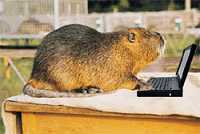 By
now you're probably wondering
what a coypu is. I know I wondered
about it myself when I first
saw the word so I looked it
up in an encyclopedia, where
I learned the following: Coypu
(myocastor coypus) is also called
nutria. In the accompanying
photo it looks to my eyes like
a cross between a woodchuck
and a rat. But much bigger,
with some of them growing to
forty pounds and more. In fact,
it's one of the largest rodents
in the world, exceeded only
by the South American capybara
and maybe by the rats that used
to live in my old neighborhood.
By
now you're probably wondering
what a coypu is. I know I wondered
about it myself when I first
saw the word so I looked it
up in an encyclopedia, where
I learned the following: Coypu
(myocastor coypus) is also called
nutria. In the accompanying
photo it looks to my eyes like
a cross between a woodchuck
and a rat. But much bigger,
with some of them growing to
forty pounds and more. In fact,
it's one of the largest rodents
in the world, exceeded only
by the South American capybara
and maybe by the rats that used
to live in my old neighborhood.
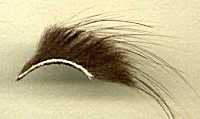 Originally
from South America, coypu are
now found all over Louisiana
and parts of Florida, where
it is raised for its fine fur.
Not wanting to become part of
somebody's fur coat, many of
them have escaped into the swamps
where they've become real pests
and have a bounty on them because
they eat just about anything--and
lots of it. Bad news for coypus
but good news for fly tyers,
especially since its body is
covered with soft, dense brownish
underfur with exceptionally
long guard hairs (see illustration),
a combination that makes for
a very "active" fly
when placed in water and a tempting
fly when placed before a fish,
at least based on the few reports
just in. The coypu I use comes
pre-cut into strips similar
to zonker strips but if you
have any coypu at home you can
easily cut it up yourself into
similar strips. If you don't
have any and you can't find
it at your local fly shop but
would like some after reading
this article, you can write
me and maybe I'll have some
extra for sale--if my order
from Norway ever arrives.
Originally
from South America, coypu are
now found all over Louisiana
and parts of Florida, where
it is raised for its fine fur.
Not wanting to become part of
somebody's fur coat, many of
them have escaped into the swamps
where they've become real pests
and have a bounty on them because
they eat just about anything--and
lots of it. Bad news for coypus
but good news for fly tyers,
especially since its body is
covered with soft, dense brownish
underfur with exceptionally
long guard hairs (see illustration),
a combination that makes for
a very "active" fly
when placed in water and a tempting
fly when placed before a fish,
at least based on the few reports
just in. The coypu I use comes
pre-cut into strips similar
to zonker strips but if you
have any coypu at home you can
easily cut it up yourself into
similar strips. If you don't
have any and you can't find
it at your local fly shop but
would like some after reading
this article, you can write
me and maybe I'll have some
extra for sale--if my order
from Norway ever arrives.
Tying the Crab Monster
 I
originally called this
fly the "Coypu Critter"
but that was before I
saw a rerun on the Late
Show of that excellent
sci-fi movie, "Attack
of the Crab Monsters."
Since I think this fly
probably is taken most
frequently for a crab,
I now call it a "Crab
Monster." Whatever
you call it, it's a very
simple fly to tie and
one that has so far taken
some very nice fish. I
look forward to trying
it out on permit down
in Belize in April and
on the stripers when they
return in the spring.
I'll report back later
on their success.
I
originally called this
fly the "Coypu Critter"
but that was before I
saw a rerun on the Late
Show of that excellent
sci-fi movie, "Attack
of the Crab Monsters."
Since I think this fly
probably is taken most
frequently for a crab,
I now call it a "Crab
Monster." Whatever
you call it, it's a very
simple fly to tie and
one that has so far taken
some very nice fish. I
look forward to trying
it out on permit down
in Belize in April and
on the stripers when they
return in the spring.
I'll report back later
on their success.
| Hook: |
Daiichi 2546 or Mustad 34007 or similar, # 4-#1 |
| Thread: |
Danville's 6/0, orange, tan, or black |
| Eyes: |
Lead barbell eyes (either plain or with eyes painted on) |
| Body: |
Coypu strip |
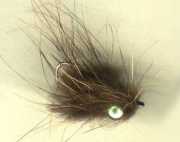 After tying in a set of lead eyes, dub some coypu underfur onto your thread and make several criss-cross wraps over and under and between the lead eyes (to fill in this space with fur).
After tying in a set of lead eyes, dub some coypu underfur onto your thread and make several criss-cross wraps over and under and between the lead eyes (to fill in this space with fur).
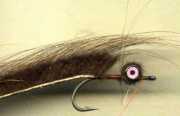 Tie in a coypu strip (with guard hair points facing forward).
Tie in a coypu strip (with guard hair points facing forward).
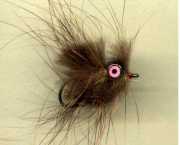 Wrap coypu strip over shank and tight up against and in front of the barbells. Tie down and trim excess.
Wrap coypu strip over shank and tight up against and in front of the barbells. Tie down and trim excess.
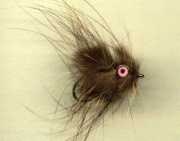 Dub some coypu underfur (with some of the shorter guard hairs still in it) onto your thread and wind it on just in back of the eye and back into the wrapped-on coypu. This step may be skipped but I feel that it gives it a more “buggy” look.
Dub some coypu underfur (with some of the shorter guard hairs still in it) onto your thread and wind it on just in back of the eye and back into the wrapped-on coypu. This step may be skipped but I feel that it gives it a more “buggy” look.
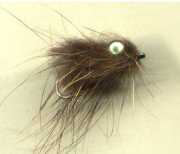 Trim the top of the body flat. The fly is intended to be fished inverted, hook point up. Use this fly anywhere crabs might be found and let me know how you do.
Trim the top of the body flat. The fly is intended to be fished inverted, hook point up. Use this fly anywhere crabs might be found and let me know how you do.
Tying the Coypu Dab (or Small Flounder)
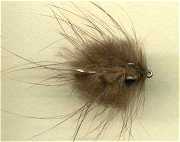 Where found, dabs are delicious treats for stripers and other game fish. The Coypu Dab is an excellent imitation of this small fish. The dressing and tying directions for this fly are the same as for the Coypu Crab Monster. It’s only the barbering that’s different. Trim the top of the fly flat and the bottom of the fly slightly less flat to approximate the shape of the natural dab. Remember, this is a fly that is meant to be fished hook point-up.
Where found, dabs are delicious treats for stripers and other game fish. The Coypu Dab is an excellent imitation of this small fish. The dressing and tying directions for this fly are the same as for the Coypu Crab Monster. It’s only the barbering that’s different. Trim the top of the fly flat and the bottom of the fly slightly less flat to approximate the shape of the natural dab. Remember, this is a fly that is meant to be fished hook point-up.
Tying the Coypu Bonefish Fly
Here's a bonus for you. I hadn't intended to include this fly in this article but I ended up with so many small scraps of coypu that I decided to put them to good use and tie up a Coypu Bonefish Fly, to illustrate one of the uses to which you can put the many scraps you're bound to end up with if you've tied any of the flies described above. So here goes.
| Hook: |
Daiichi 2546 or Mustad 34007 or similar, # 6-2 |
| Thread: |
Danville's 6/0, orange or tan |
| Eyes: |
Bead-chain eyes |
| Body: |
Coypu dubbing |
| Wing: |
Short Coypu strip |
| Head: |
Dubbed Coypu |
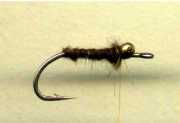 Dub onto your thread some coypu underfur (remove the really long guard hairs first) and wrap over shank up to the bead-chain eyes.
Dub onto your thread some coypu underfur (remove the really long guard hairs first) and wrap over shank up to the bead-chain eyes.
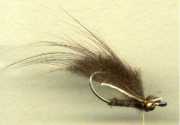 Turn up upside down and tie in a short strip of coypu (skin should not be longer than hook).
Turn up upside down and tie in a short strip of coypu (skin should not be longer than hook).
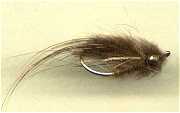 Dub some more coypu onto your thread and wrap this just in back of and just in front of the bead-chain eyes, then criss-cross over and under and between the eyes, filling in this space with fur. Whip finish and tie off. Pick out fur so that it blends with wing.
Dub some more coypu onto your thread and wrap this just in back of and just in front of the bead-chain eyes, then criss-cross over and under and between the eyes, filling in this space with fur. Whip finish and tie off. Pick out fur so that it blends with wing.






